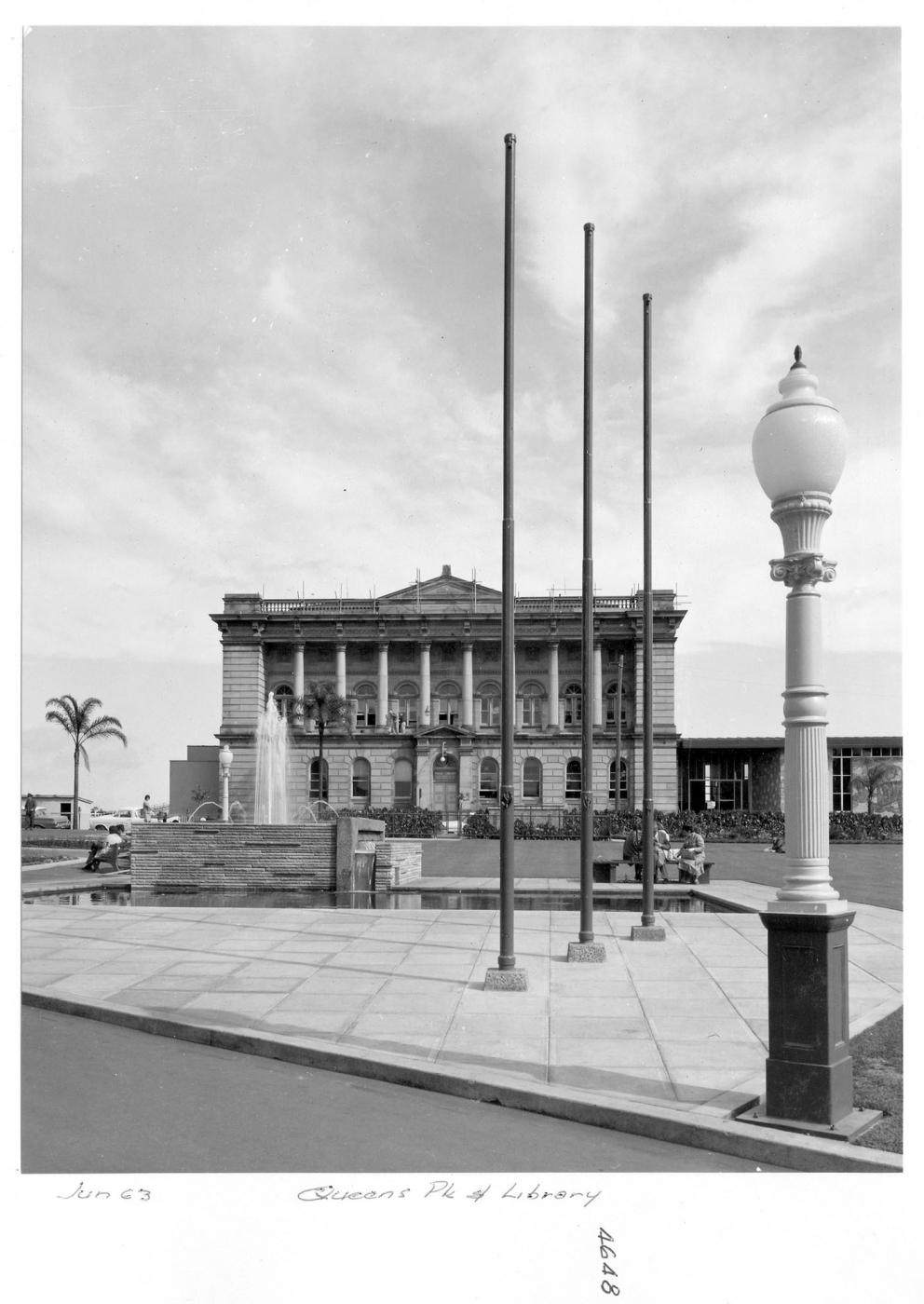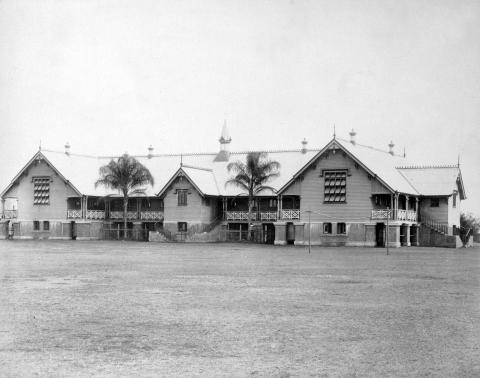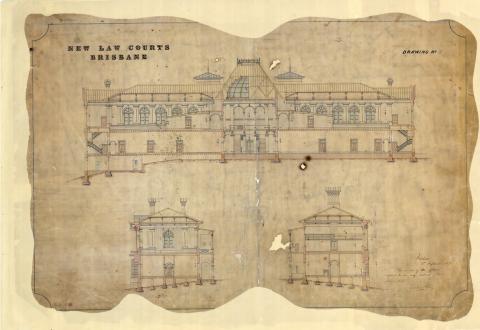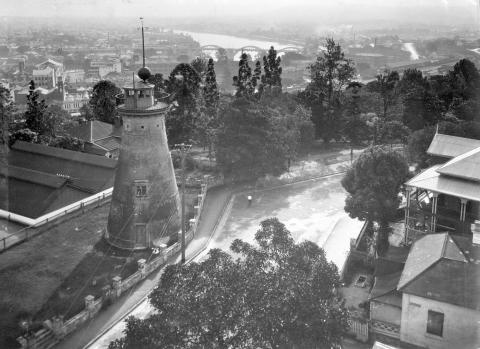
- News of the day
-
Telegraph, Wednesday 16 January 1935, page 11
FUTURE ART GALLERY PART OF BIG BUILDING PLAN
Many Government Schemes Afoot
New Courts and Library Included
Although many people are keen on the building of a new art gallery the problem is by no means simple. It is known that the Government is not looking upon this, art gallery problem as an isolated one, but rather as one linked inseparably with several other very important public schemes, all of which have to be considered together and in relation to each other. At the present moment the Government is giving careful and weighty consideration to quite a comprehensive scheme, which includes the extension of Adelaide Street through to North Quay, and the subsequent provision of new railway offices, new police courts and petty sessions office, new watch house, a new public library, the removal of the present C.I.B. headquarters from Queen's Park (thus making the park a complete square) and a new art gallery.
Naturally each and every one of these projects requires careful consideration within itself, as well as in relation to the others.
For instance, it is obvious that the police courts and petty sessions office as well as the watchhouse will have to be disturbed if the street is to go through to the Quay. That, then, opens up a new line of inquiry. Where put the courts, so that they may be central, and (vital point) away, from undue traffic noises? Where put the watchhouse (which must be close to the police courts) so that it will not be conspicuous to the public gaze. The side which holds most favour at the moment, it is understood, is a position in William Street close to the present public library. It might even be made to incorporate the library itself, but that is a moot point.
Such a situation would be away from traffic noise, and a watchhouse built behind it would-be easily accessible to the police cars which bring their daily human freight from Boggo Road gaol without their having to be paraded too openly in the main city thoroughfares.
Of the crying need for a better public library there can be no doubt. The Government recognises that need, just as it recognises the need for something in the way of a better and, more central art gallery.
PERFECT EXECUTIVE BLOCK.
The main considerations underlying the next move in the scheme is to create the perfect executive block, with the Taxation building, the Executive building, the Treasury building, and Queen's Park as a starting point. The first thing to do is to remove the police buildings from Queen's Park and make it a perfect open square. The next is to use the available land along William Sheet in a proper manner to make the buildings on that side of the square: harmonise and blend and balance those on the remaining three sides. Into this scheme new police courts, and petty sessions office fit very snugly.
PUBLIC LIBRARY SCHEMES.
It is unlikely that the present public library building will be allowed to remain, although architecturally it could be made to fit in very well with such a scheme. The question of a new library, with which has been linked that of a new art gallery then comes up for consideration. In this connection there seems to be little doubt that the Government's eyes are straying to Wickham Park. It is believed that a public library will sooner or later rear its beautiful head at a spot in this park directly opposite the present Water Supply and Beverage offices. It also seems certain that the Government will favour some site adjacent to this one for the erection of a new Art Gallery. Many suggestions have been put forward, even one involving the erection of a building in the centre of the Botanic Gardens. This might very well bring in another long train of speculation regarding the building of a new University at St Lucia and the use to which the buildings thus vacated might be put. But St Lucia, it would seem, will remain a dream for some years to come. It is unlikely, however, that the Botanic Gardens suggestion will be considered seriously.
Another point worthy of consideration is whether, when the time for action comes, the plans for these new public buildings will be prepared by Government offices or by architects in open are public buildings and not buildings built more especially for State use, or for the housing of State officials, the public ought .to contribute something to their design. It will most likely be left to the public architects, therefore, to submit plans, especially of the major buildings such as the library and art gallery.
If Mr. Forgan Smith is returned as power next May, it is almost certain that the Government will push' forward with this comprehensive scheme.
- Background
-
Queens Gardens was established in several stages between 1905 and 1962, on a site which has been associated both with the earliest phase of the penal settlement at Moreton Bay, and with the establishment of the Church of England in Queensland.
During the convict era the engineer's weatherboard cottage stood on part of the site, at the corner of William and Elizabeth Streets. It appears to have been both the first house and the first sawn timber building to be erected in Brisbane Town.
Occupying most of the remainder of the site was a lumber yard, erected c.1825, which contained the engineer's stores and workshops. By 1838 the lumber yard had been moved, and the cottage had been converted into offices. The section of the present park along George Street was part of the chaplain's garden from 1840 at least.
In 1848 the site was acquired by the Church of England. A parsonage was constructed at the corner of William and Elizabeth Streets in 1850-51, and St John's Church was erected on the site, further along William Street, in 1850-54. In 1868 it was extended. A detached bell tower was erected in 1877, and in 1879-80 a building which served as church school, synod hall, library and committee rooms was built in the eastern corner of the site.
In the 1880s the Church proclaimed the square a future cathedral site, and a new Church Institute and Synod Hall was erected in the northern corner of the square in 1897.
Following church protests at the 1899 announcement of plans to erect a new lands and survey building adjacent to the pro-cathedral, the government offered to purchase the church square, and acquired it the same year.
In 1901 the Church Institute building was occupied by the Police Department and later served as offices for the Criminal Investigation Branch.
In 1904 the pro-cathedral, belltower, church school and parsonage were demolished and a 0.25 hectare, 30 metre wide strip between William and George Streets, adjacent to the new Executive Building, was proclaimed as the Executive Gardens.
A bronze statue of Queen Victoria, a replica by English sculptor Thomas Brock of the original in Portsmouth, was erected in mid-1906. The purchase was arranged by local artist Godfrey Rivers, and was funded by public subscription and subsidies from state and local government. The pedestal was designed by the Public Works Department and crafted by local stonemason William Kitchen, at a cost of £567.
The statue was an expression of Queensland's loyalty to the British Empire. On Empire Day veterans from the Crimean, Sudan and South African wars gathered in what became known as the Queens Gardens, which became also an assembly point for state occasions such as funeral or celebratory processions. The monument remains the only statue of Queen Victoria in Brisbane.
In late 1906 the reserve was extended to an area of 0.37 hectares, with the inclusion of the site of the former parsonage.
In 1917 a Krupp 77mm field gun, captured from the German army in France in 1915, was placed in the gardens. It was a gift from King George V, at the request of Thomas Joseph Ryan, lawyer, anti-conscriptionist and Queensland Labor Premier 1915-1919.
A bronze statue of TJ Ryan, designed by Australian sculptor Bertram MacKennal and erected by public subscription, was unveiled in the gardens in 1925. The sandstone base was provided by the Brisbane City Council.
In 1962 the CIB building at the northern corner of the site was demolished and the park was extended to occupy the entire square, with a total area of 0.48 hectares. A new layout for the gardens was prepared as a joint state and local government scheme in preparation for the visit of Queen Elizabeth II to Brisbane in March 1963. Brisbane City Council landscape architect, horticulturalist and author, Harry Oakman, was responsible for the design and landscaping, and architectural detailing was undertaken by Department of Works architect Graham De Gruchy.
In 1990 the Queensland Service Women's Association erected a Monument of Memories in the park, honouring the 70,000 service women.
Courtesy of Queensland Heritage Register
/153.024353,-27.472295,7/450x450@2x.png?access_token=pk.eyJ1IjoicXNhLWRpc2NvLXFsZCIsImEiOiJjamJmdTgyZXEyeWNjMnlxZm8xcmtieHgxIn0.lmT9J5tTPKGuuccQgCVSAg)



